
The “most intelligent photograph ever taken”, as it is sometimes known, was captured during the Fifth Solvay International Conference on Electrons and Photons held in 1927 in Brussels, Belgium. The photograph is famous because it was captured at the outset of what would later be known as the “debate of the century” over the non-deterministic nature of quantum physics. The central discussion of the debate is covered in the May 25th newsletter ‘The Bohr-Einstein Debate’
Among those present at the 1927 Solvay conference, on one side of the debate were the originators of the newly devised quantum mechanics, including Werner Heisenberg (1901-76) himself, in addition to his collaborators Wolfgang Pauli (1900-58), Max Born (1882-1970), Hendrik Kramers (1894-1952), Louis de Broglie (1892-1987), Niels Bohr (1885-1962) and Paul Dirac (1902-84). On the other side of debate, also present, were supporters of the classical/deterministic paradigm, represented most prominently by Albert Einstein (1879-1955), but also Max Planck (1858-1947), Hendrik Lorentz (1853-1928), Paul Ehrenfest (1880-1933) and, at the time, Erwin Schrödinger (1887-1961).
Of the 29 attendees at the meeting, 17 had or would go on to win the Nobel Prize in physics or chemistry. Among them was Marie Curie (1867-1934) who had already won both:
Nobel Laureates in Physics
Hendrik Lorentz (1902), Marie Curie (1903), Lawrence Bragg (1915), Max Planck (1918), Albert Einstein (1921), Niels Bohr (1922), Arthur Compton (1927), C.T.R. Wilson (1927), Owen Richardson (1928), Louis de Broglie (1929), Werner Heisenberg (1932), Paul Dirac (1933), Erwin Schrödinger (1933), Wolfgang Pauli (1945), Max Born (1954)Nobel Laureates in Chemistry
Marie Curie (1911), Irving Langmuir (1932), Peter Debye (1936)
This week’s newsletter is an introduction to the so-called “golden age of quantum physics” through the lens of the remarkable group photograph above, highlighting its most influential protagonists and their views during the time of the Fifth Solvay Conference in 1927.
The Fifth Solvay International Conference (1927)
The Fifth Solvay International Conference on Electrons and Photons was held in October 1927 in Brussels, Belgium. Continuing on since the successful inaugural conference of 1911, the Solvay gatherings are devoted to outstanding preeminent open problems in physics, and occur approximately every three years. From 1913 to 1961, every gathering revolved around open problems in quantum theory.
Chaired by Hendrik Lorentz in 1927, the stated topic of the conference was “photons and electrons”. In practice, the 1927 conference revolved around the growing dispute between two emerging schools of physics: those fascinated and enthralled by the new quantum mechanics introduced by Heisenberg, and those still clinging to the superseded deterministic paradigm.
The Back Row

Proceeding from the left side of the back row, we see several familiar faces, in addition to some who are lesser known. Auguste Piccard (1884–1962), for instance, we know as the Swiss physicist, inventor and explorer most well known for his daring, record-shattering helium-filled balloon flights and invention of the first bathyscaphe, which he used to conduct unmanned dives to explore the ocean’s depths as early as 1948. Émile Henriot (1885–1961), student of Marie Curie, was a French chemist notable for first showing that potassium and rubidium are naturally radioactive materials. Well-known close personal friend of Einstein, the Dutch-Austrian physicist Paul Ehrenfest (1880–1933), whose doctoral adviser was Ludwig Boltzmann (1844-1906), in his own right made major contributions to statistical mechanics and its relationship with quantum mechanics, including the theory of phase transition.
Continuing rightwards, we find Édouard Herzen (1877–1936), a Belgian chemist who collaborated with the industrialist Ernest Solvay (1838-1922) who started the conference in 1911. Jules-Émile Verschaffelt (1870–1955) and Théophile de Donder (1872–1957) were both Belgian physicists, the latter most well known for his development of correlations between the Newtonian concept of chemical affinity and the Gibbsian concept of free energy. Ralph Fowler (1889–1944) was a British physicist and astronomer from Cambridge, perhaps most well known for supervising and collaborating with Dirac on the statistical mechanics of white dwarf stars, for introducing Dirac to quantum theory and for putting Dirac and Heisenberg in touch with one another through Niels Bohr. Leon Brillouin (1889–1969) was a French physicist who wrote his dissertation on the quantum theory of solids and the year before the conference, independently with Gregor Wentzel (1898–1978) and Hendrik Kramers (1894–1952) developed what is now know as the Wentzel-Kramers-Brillouin approximation for finding solutions to linear differential equations with spatially varying coefficients.
In addition to these brilliant men, for the purposes of our story, three names from the back row pop out:
- Werner Heisenberg (1901–1976)
- Wolfgang Pauli (1900–1958)
- Edwin Schrödinger (1887–1961)
Werner Heisenberg
The 26 year old German physicist Werner Heisenberg had been the one who in his 1925 breakthrough paper Über quantentheoretische Umdeutung kinematischer und mechanischer Beziehungen (“Quantum theoretical re-interpretation of kinematic and mechanical relations”) laid the foundation for matrix mechanics, the first conceptually autonomous and logically consistent formulation of quantum mechanics.
Reportedly, Heisenberg in correspondence with Pauli had been working on the paper while recovering from hay fever. The purpose of the paper was to attempt to describe the energy levels of a one-dimensional anharmonic oscillator via observable parameters such as transition probabilities for quantum jumps. Heisenberg sent the paper to Max Born in July of 1925 to review and decide whether he should submit it for publication. He did so in August of 1925, and the paper was published in Zeitschrift für Physik in September of the same year.
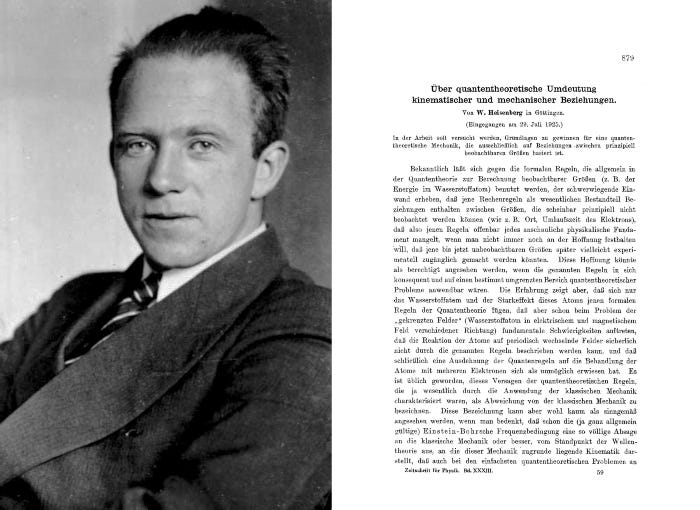
By February two years later, Heisenberg had his next revolutionary paper Über den anschaulichen Inhalt der quantentheoretischen Kinematik und Mechanik (“On the Descriptive Content of Quantum Kinematics and Mechanics”) where he introduced the Heisenberg uncertainty principle in draft form. Reportedly, he inquired to Niels Bohr to have it forwarded to Einstein (American Institute of Physics, 1998) for review, which Bohr did.
“Even in principle, we cannot know the present in all detail. For that reason everything observed is a selection from a plenitude of possibilities and a limitation on what is possible in the future…. The more precisely the position is determined, the less precisely the momentum is known in this instant, and vice versa.” — Heisenberg (1927)
Heisenberg’s uncertainty principle essentially consists of mathematical inequalities which famously assert that there are fundamental limits to the precision with which certain pairs of physical properties of particles can be known. Combined with his introduction of matrix mechanics, the publication helped Heisenberg win the 1932 Nobel Prize in Physics for nothing less than
“The creation of quantum mechanics” — The Nobel Committee (1932)
More about Heisenberg’s work and his relationship with Einstein can be found in the June 11th 2021 newsletter on ‘When Heisenberg met Einstein’:
When Heisenberg met Einstein
A mere 24 years old, Werner Heisenberg (1901-76) in 1925 developed a treatment of electron behavior based solely on directly observable quantities such as the frequencies of light that atoms absorb and emit. Recovering from hay fever on the island of Heligoland…
Wolfgang Pauli
Shortly after Heisenberg published his 1925 paper introducing the matrix theory of modern quantum mechanics, his collaborator, the Austrian-born Wolfgang Pauli used it to derive the observed spectrum of the hydrogen atom in his paper Über das Wasserstoffspektrum vom Standpunkt der neuen Quantenmechanik (“On the Hydrogen Spectrum from the Standpoint of the new Quantum Mechanics”) and so provide the first validation of Heisenberg’s theory. As Pauli explains in the abstract of the paper:
“It is shown that the Balmer terms of an atom with a single electron are yielded correctly by the new quantum mechanics and that the difficulties which arose in the old theory … disappear in the new theory.”
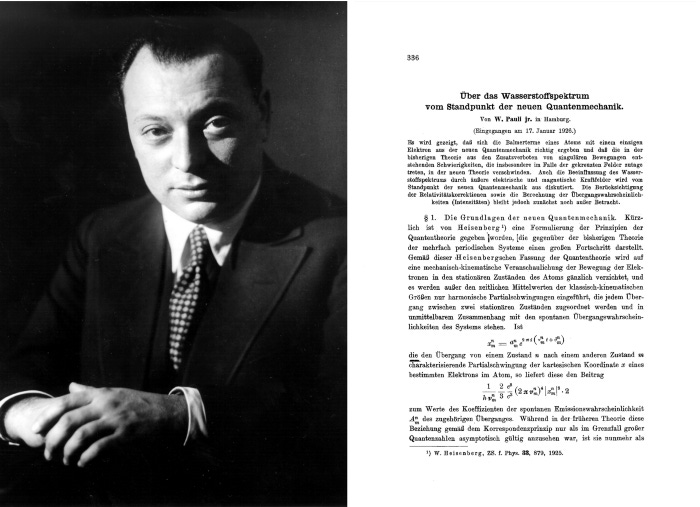
About the work, Max Born would later state that from the moment of the publication of Pauli’s calculation, “there was no longer any doubt about the correctness of the theory [referring to quantum mechanics] among physicists” (Born, 1956).
Erwin Schrödinger
By the time of the conference in 1927, legendary Austrian physicist Erwin Schrödinger was 40 years old and had been a full professor for six years, first at the University of Wroclaw, then later at the University of Zürich. At the time of the conference, he had recently succeeded Max Planck (also present) at the Friedrich Wilhelm University in Berlin.
The name Schrödinger is now perhaps most well known for his later formulation of the popular quantum-mechanical thought experiment “Schrödinger’s cat”. His most significant contribution to physics however, was made in 1926 with the publication of his paper Quantisierung als Eigenwertproblem (“Quantization as an Eigenvalue Problem”) where Schrödinger introduced the so-called Schrödinger equation which describes the wave function of a quantum-mechanical system, and so laid the foundation for what became known as wave mechanics.

Schrödinger would go on to win the 1933 Nobel Prize in Physics alongside Paul Dirac for their “discovery of new productive forms of atomic theory”.
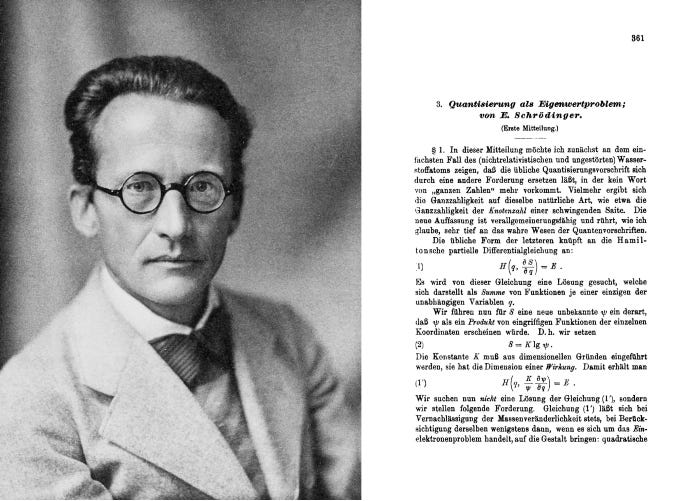
Famously, despite playing a significant role in the foundation of quantum mechanics, Schrödinger was never entirely comfortable with its implications, later writing that “I don’t like it and I’m sorry I ever had anything to do with it”. His proposition of Schrödinger’s cat was in fact an attempt at ridiculing the implications of the non-deterministic view of physics he had helped create.
The Middle Row

Moving on to the middle row. Again from the the left we see another Nobel Laureate, Dutch chemist Peter Debye (1884–1966) who is known primarily for his application of the concept of dipole moment to the charge distribution in asymmetric molecules. On his immediate left, we see Martin Knudsen (1871–1949), the Danish physicist known for his study of molecular gas flow and the development of the Knudsen cell, and Lawrence Bragg (1890–1971), the British physicist, pioneering x-ray crystallographer and 1915 Nobel Laureate. Also present, next to Dirac, is the 1927 Nobel Laureate, the American physicist Arthur Compton (1892–1962), known both for his discovery of the Compton effect which demonstrated the particle nature of electromagnetic radiation and for his later contributions to the Manhattan Project. Louis de Broglie (1892–1987), student of Paul Langevin (front row) was also there. de Broglie was the person who first (in his 1924 PhD thesis) postulated the wave nature of electrons and suggested that all matter has wave properties. Known now as the “de Broglie hypothesis”, it was de Broglie’s idea that Schrödinger had used in his formulation of wave mechanics. Following its experimental verification in 1927 by the Davisson-Germer experiment, de Broglie was awarded his Nobel Prize in physics in 1929.
In addition to these brilliant men, we again focus our attention towards a handful of individuals who were especially prominent in the formulation of early quantum theory. These are:
- Niels Bohr (1885–1962)
- Max Born (1882–1970)
- Paul Dirac (1902–1984)
Niels Bohr
Niels Bohr, 42 years old at the time of the conference, was of course the Danish physicist most well known for his (and Ernest Rutherford’s) 1913 formulation of the Bohr model of the atom which proposes that energy levels of electrons are discrete and that the electrons revolve in stable orbits around the atomic nucleus but can jump from one energy level (orbit) to another. The model won Bohr the Nobel Prize in Physics in 1922. In the 30s, he would be instrumental in helping refugees escape Nazism. After Denmark was occupied by the Germans, Bohr personally lobbied Heisenberg (by then the head of the German nuclear weapons program) about the implications of nuclear war (accounts differ on the exact content of their conversation). He was also part of the British mission to the Manhattan project (later dramatized in episode four of the excellent TV-series ‘Manhattan’) and also involved in the establishment of CERN in Geneva.
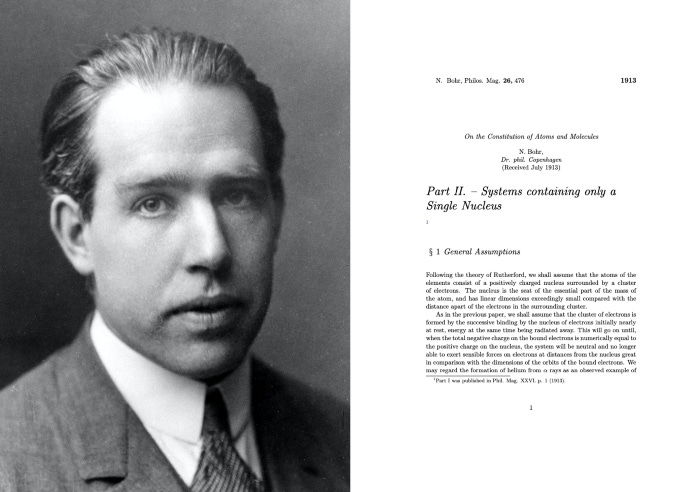
Prior to the conference, Heisenberg had been working as a lecturer at Bohr’s Institute for Theoretical Physics at the University of Copenhagen. Bohr had forwarded Heisenberg’s paper introducing the uncertainty principle to Einstein. During the conference, Bohr led the charge to defend the implications of Heisenberg’s work by debating Einstein over his criticism illustrated through the now-famous “slit experiment”:
Thought Experiment: The Slit Experiment
Consider a particle passing through a slit of width d. The slit introduces uncertainty in momentum of approximately h/d because the particle passes through the wall. But, let us determine the momentum of the particle by measuring the recoil of the wall. In doing so, we find the momentum of the particle to arbitrary accuracy by conservation of momentum.
Bohr’s elegant response was simple: He argued that the wall which the photon passes through is indeed a quantum mechanical system as well. As such, in order to measure the recoil of the wall to an accuracy of Δp, the momentum of the wall must also be known to this accuracy before the particle passes through. The implication is that at this degree of accuracy, the position of the wall is in fact uncertain as well, just as it is for the particle passing through it. As such, the position of the slit is equal to h/Δp and if the wall’s momentum is known precisely enough to measure the recoil, the slit’s position is uncertain enough to disallow a measurement of its position, in accordance with Heisenberg’s uncertainty principle.
Bohr’s triumph in the debate and his close relationship with Heisenberg at the University of Copenhagen led to the colloquial naming of the non-deterministic view spearheaded by Heisenberg, Bohr, Born and others as the “Copenhagen interpretation” of quantum physics.
Paul Dirac
By now, Dirac is one of the most recognized names in quantum physics. Then age 25, Dirac was at the time of the conference a researcher under Ralph Fowler (back row) in Cambridge. The year before, he had completed his Ph.D with the first ever thesis on Heisenberg’s quantum mechanics.
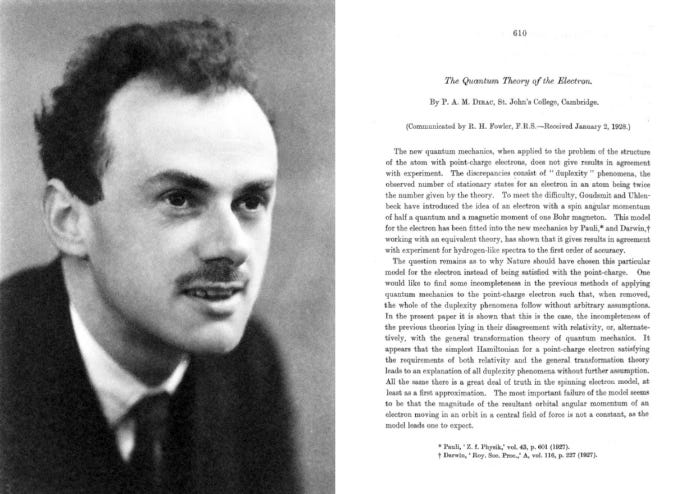
Dirac’s contribution that led to his Ph.D. occurred in 1925. His supervisor (Fowler) had received a proof copy of Heisenberg’s paper where he introduced matrix mechanics for the first time, and gave it to Dirac for him to examine. Dirac noticed a curious mathematical relationship which he later realized had the same structure as the Poisson brackets that occur in the classical dynamics of particle motion. The realization led to his introduction of a quantum theory based on non-commuting dynamic variables, which allowed him to obtain novel and illuminating quantization rules (the process of transitioning from a classical to a quantum understanding of physics), the so-called canonical quantization procedure. His rules incorporated the ideas of both Heisenberg’s matrix mechanics and Schrödinger’s wave mechanics and showed that they were in fact equivalent. As his admirer and fellow Lucasian Professor of Mathematics at Cambridge, Stephen Hawking would later write, “Of the three founders of modern quantum mechanics, Heisenberg and Schrödinger can claim to have caught the first glimpses of the theory. But it was Dirac who put them together and revealed the whole picture”.
A year after the Solvay conference, Dirac discovered, independently of Pauli, what is now known as the Dirac equation which describes all spin-½ massive particles, such as electron and quarks for which parity is a symmetry. The discovery was the first to imply the existence of antimatter, which was experimentally confirmed only several years later. Dirac would go on to share the 1933 Nobel Prize in Physics with Schrödinger for “the discovery of new productive forms of atomic theory”.
Max Born
Finally, in the middle row, we also find the German physicist and mathematician Max Born who—although not as famous as Heisenberg—was highly instrumental in the development of matrix mechanics and the formulation of the probability density function later used by Erwin Schrödinger in the Schrödinger equation.
It was Born who the year before the conference, in response to Heisenberg’s 1925 publication had proposed that quantum mechanics were best understood by probabilities. What is now known simply as the Born rule, gives the probability that a measurement on a quantum system will yield a given result. It was first introduced by Born in the 1926 paper Zur Quantenmechanik der Stoßvorgänge (“On the Quantum Mechanics of Collisions”). In the paper, Born solves the Schrödinger equation (postulateda year before) for a scattering problem. The rule is now considered a fundamental law of quantum mechanics.
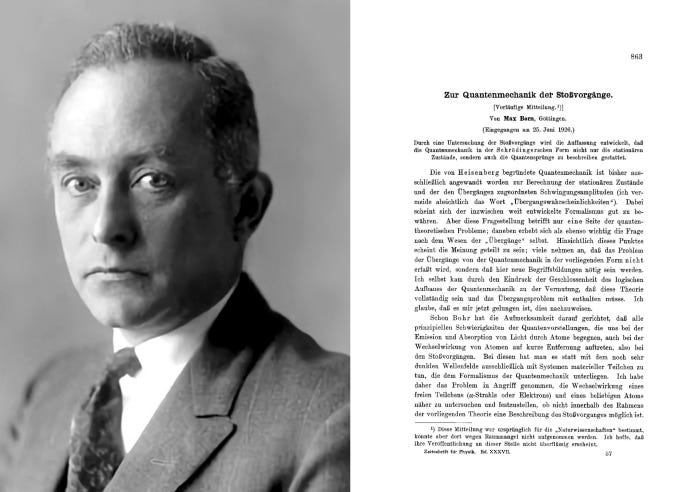
By the time of the conference in October 1927, Born and Heisenberg were famously so confident in their results that they proclaimed that quantum mechanics was “complete and irrevocable”:
“While we consider.. a quantum mechanical treatment of the electromagnetic field.. as not yet finished, we consider quantum mechanics to be a closed theory, whose fundamental physical and mathematical assumptions are no longer susceptible of any modification.. On the question of the ‘validity of the law of causality’ we have this opinion: as long as one takes into account only experiments that lie in the domain of our currently acquired physical and quantum mechanical experience, the assumption of indeterminism in principle, here taken as fundamental, agrees with experience.”
– Born & Heisenberg (1927). ‘Quantum Mechanics’. Proceedings of the Fifth Solvay Congress
The Front Row

Finally, the front row of the photograph is largely dominated by the (by then) older guard of physics, some of whom worked in quantum physics and others who did not.
Madame Marie Curie (1867–1934), the only person at the conference who had won the Nobel in both physics (1903) and chemistry (1911), never worked on quantum theory. Rather, she did her monumental work on the nature and properties of radioactivity and for her discovery of the elements radium and polonium, and her successful isolation and study of the properties of the former. The chair of the conference Hendrik Lorentz similarly never published research on quantum physics, although he did give a lecture series on the topic at Cornell in 1926.
Irving Langmuir (1881–1957) was an American chemist and physicist who won the Nobel Prize in 1932 for his work on surface chemistry. The French physicist Paul Langevin (1872–1946) is now primarily best known for his development of Langevin dynamics and the Langevin equation, as well as as the supervisor of Louis de Broglie and Léon Brillouin (also present). On his left, the Swiss physicist Charles-Eugéne Guye (1866–1942) was one of Einstein’s teachers at ETH Zurich whose experimental results were among the first to support the predictions of Lorentz and Einstein on special relativity. The Scottish Charles Thomson Rees Wilson (1869–1959) was a physicist and meteorologist who had won the Nobel Prize in the year of the conference, for his invention of the so-called cloud chamber, a particle detector used for visualizing the passage of ionizing radiation. The following year, the Nobel was awarded to the man on Wilson’s left, Owen Richardson (1879–1959), a British physicist most well known for his work on thermionic emission and the derivation of Richardson’s law.
Front and center in our debate however, most notably, were two older men:
- Max Planck (1858–1947)
- Albert Einstein (1879–1955)
Max Planck
The older Planck played an early and crucial role in the establishment of quantum physics with his introduction in 1900 of the famous Planck black-body radiation law, or simply Planck’s Law. Later utilized by both Einstein and Schrödinger in their Nobel Prize award-winning papers, Planck’s law describes the spectral density of electromagnetic radiation emitted by a black body in thermal equilibrium.
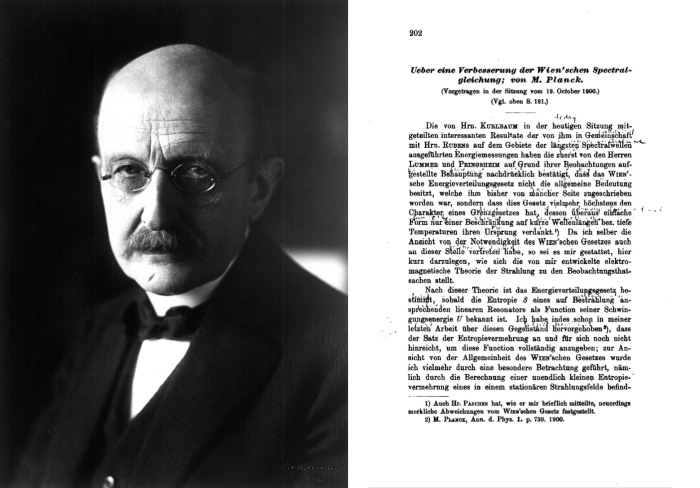
Planck had won the 1918 Nobel Prize in Physics for his early work on quantum theory, however he rejected Heisenberg and Born’s quantum mechanics, expecting that Schrödinger’s wave mechanics would soon render quantum mechanics unnecessary.
“He was, by nature, a conservative mind; he had nothing of the revolutionary and was thoroughly skeptical about speculations. Yet his belief in the compelling force of logical reasoning from facts was so strong that he did not flinch from announcing the most revolutionary idea which ever has shaken physics.” – Max Born about Planck
Albert Einstein
Finally, of course, there in the front sat Albert Einstein. At this point 48 years old, Einstein had by the time of the conference revolutionized physics many times over by introducing, among other results, special and general relativity, mass-energy equivalence and the nature of the photoelectric effect. He had already been awarded his Nobel Prize in 1921, but following the publication of Heisenberg’s 1925 paper introducing matrix mechanics, was famously displeased with the direction modern physics was heading. A staunch determinist, his famous line
I, in any case, am convinced that He does not play dice. — Einstein
was made during the Solvay conference in his confrontation with Bohr. The pair’s well-known and public debate on the topic lasted until the publication of the so-called Einstein-Podolsky-Rosen paper in 1935, entitled Can Quantum-Mechanical Description of Physical Reality be Considered Complete?
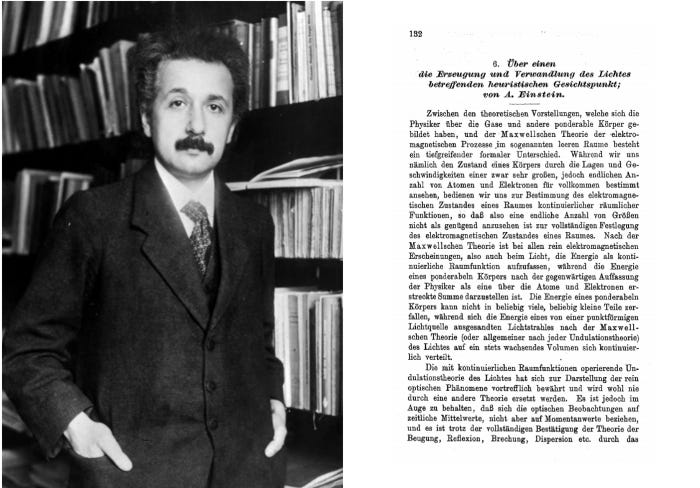
A year after the conference, despite their disagreements, Einstein nominated both Heisenberg and Born for the Nobel Prize. He would later also nominate Wolfgang Pauli (1945). Although they did not meet very often, or correspond very voluminously, Einstein and Bohr’s mutual admiration persisted, as Einstein’s secretary Helen Dukas later stated:
“They loved each other warmly and dearly”
Quite surprisingly, there is a small video from the 1927 Solvay Conference shot by an assistant of Irving Langmuir. This short video is now available on Youtube, and is linked below with commentary by Nancy Thorndike Greenspan.
In this 3 minute silent film of the conference, 21 of the 29 participants can be seen conversing, during an intermission of the Summit’s proceedings.
Yours,
Dr Churchill
PS:
In the event that you are interested in reading more about the “birth age” of quantum physics — you are encouraged to look up the following three books:
- Purrington, R. D. 2018. The Heroic Age. The Creation of Quantum Mechanics 1925-1940*. Oxford University Press.
- Greenspan, N. T. 2005. The End of the Certain World. The Life and Science of Max Born*. Wiley.
- Kumar, M. 2008. Quantum. Einstein, Bohr and the Great Debate about the Nature of Reality*. Icon Books.


Leave a comment